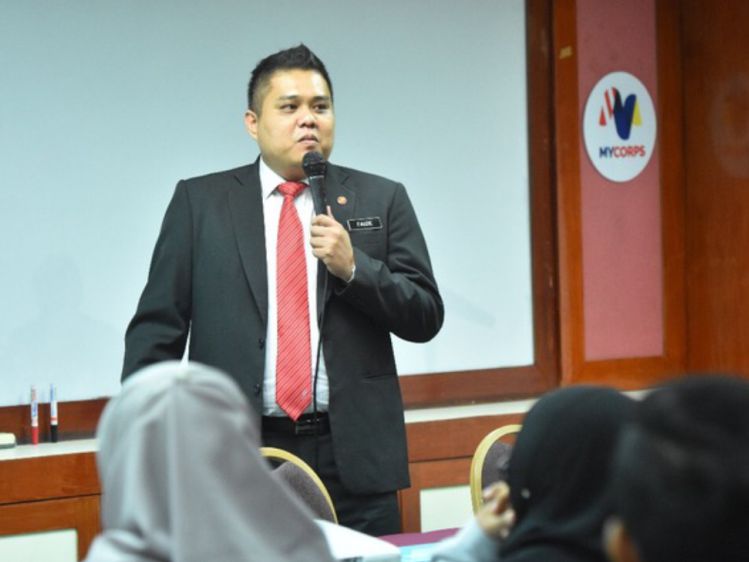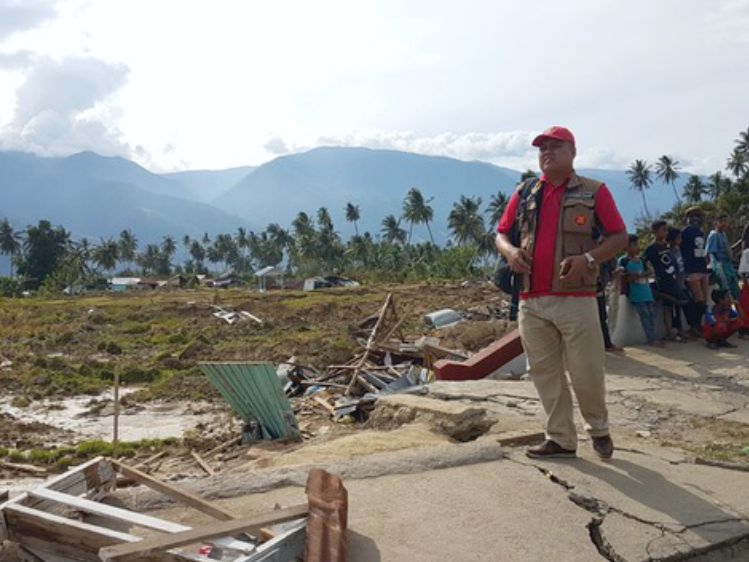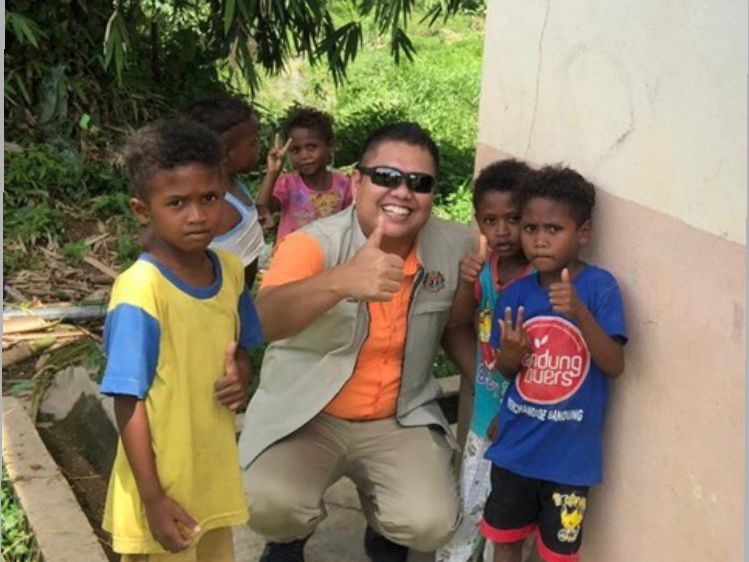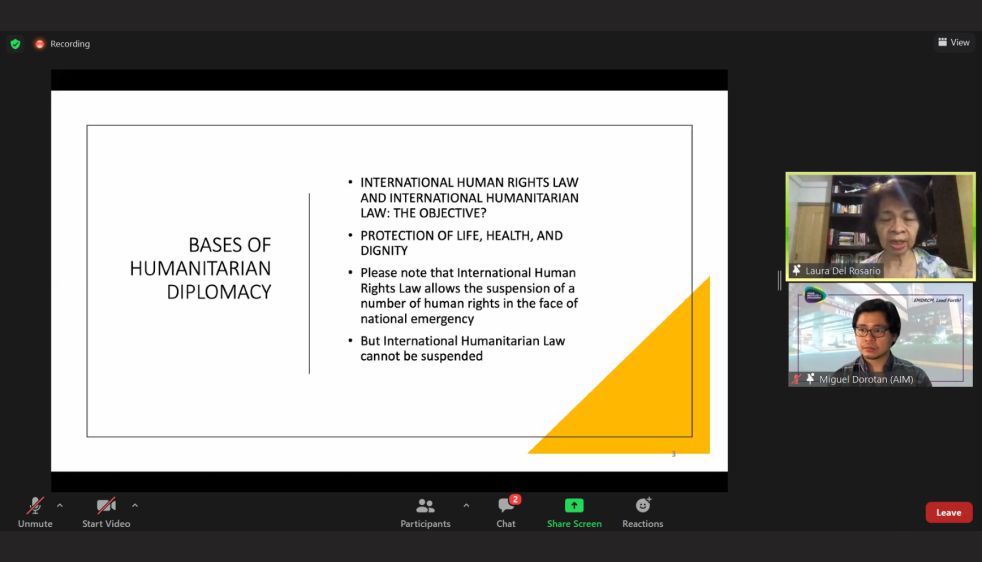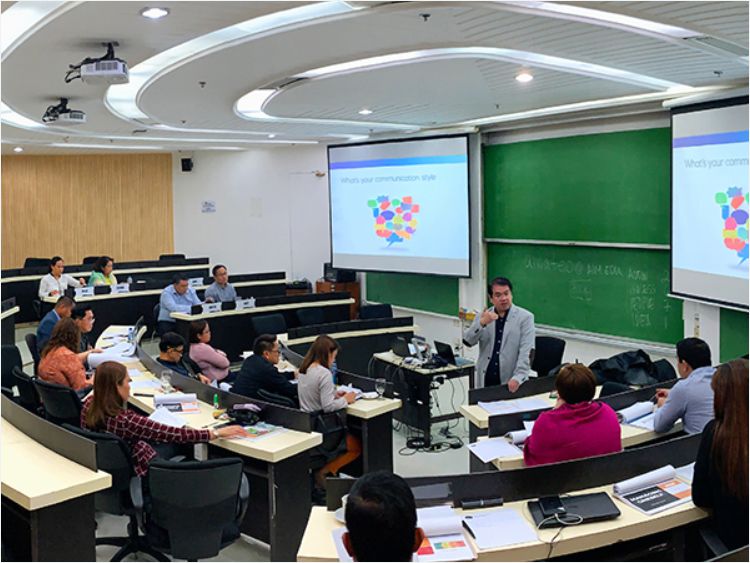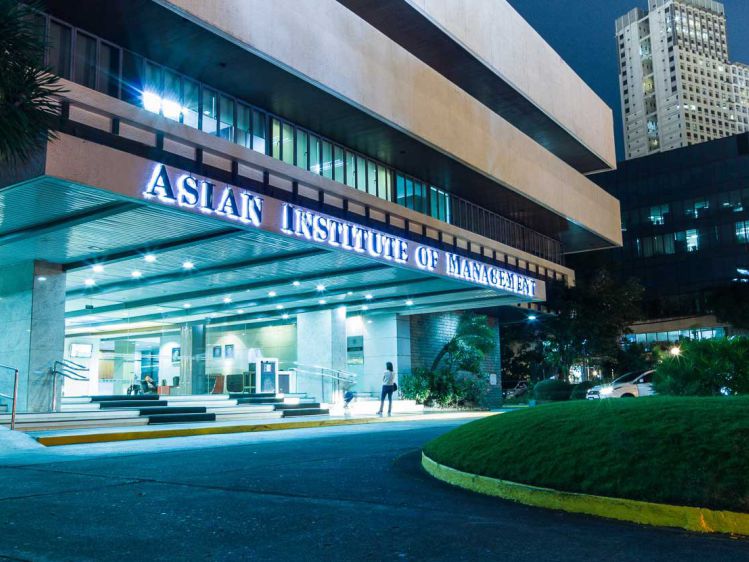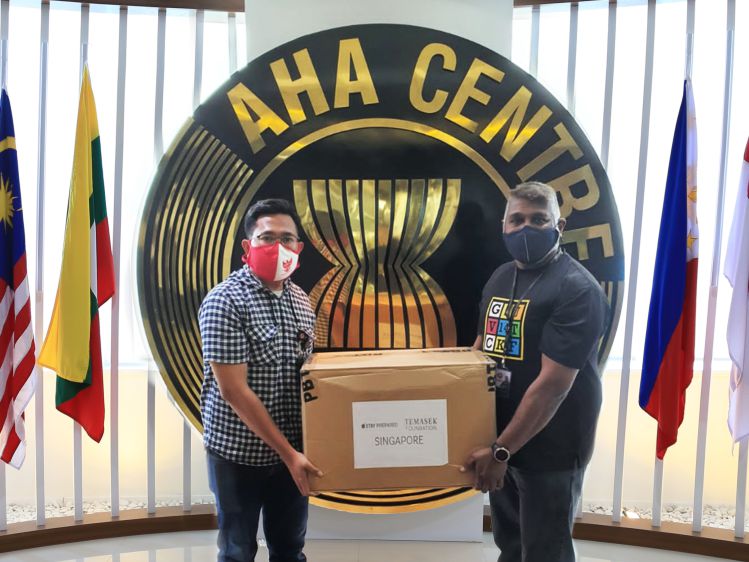Vol 68 – MUHAMMAD FAUZIE ISMAIL

MUHAMMAD FAUZIE ISMAIL
This month, Muhammad Fauzie Ismail from the National Disaster Management Agency (NADMA) of Malaysia chats to the AHA Centre about his regional disaster management experience. As an AHA Centre Executive (ACE) Programme graduate in 2015, Fauzie spoke about his experience and his hopes for disaster management in Malaysia and the wider ASEAN region.
Fauzie returned back to NADMA in 2019 after completing a Masters in Emergency Response and Planning at University Putra Malaysia (UPM) Malaysia, and was assigned to the Community and Social Development Section, Post Disaster Management Division. “In general, my work involves planning and implementing community development programmes with the aim to create a resilient community towards disaster through Disaster Risk Reduction initiatives”, Fauzie says. “This includes collaborating with all stakeholders using the whole-of-society approach at all levels through integrated planning.” Fauzie also tells us that in disaster response, his primary role is to support coordinating all the Non-Governmental Organisations (NGOs) who work within the initial government response.
A graduate of the AHA Centre’s ACE Programme supported under Japan-ASEAN Integration Fund (JAIF), Fauzie highlights its impact on his understanding and skills across all areas of disaster management. He also remembers the role of the programme in extending his networks by engaging with other disaster managers from across ASEAN – with whom he remains in contact to this day.
“It also helped develop my confidence to share and explore new ways of doing things when managing disaster”
-Muhammad Fauzie Ismail
Having been involved in a number of disaster responses over the years, Fauzie remembers the 2018 Central Sulawesi response vividly. “Despite being able to experience the actual deployment first-hand, the most valuable learning point was the importance of having effective training – especially from the ASEAN-ERAT Induction Course, ARDEX and other similar trainings” Fauzie says. “These trainings are carefully constructed to enable the participants to visualise the real situation, and I feel that all these trainings really prepared me prior to actual deployment.”
More recently Fauzie’s challenges are related to the national response to the COVID-19 pandemic, in which he is working to support community behaviour change within the ‘new normal’. Without face-to-face communication and with social distancing, he and his team have to be creative to find new ways to relay messages down to the community at grassroots level. While the pandemic may have added extra challenges, Fauzie still highlights the importance of technology in the future of ASEAN disaster management.
“I believe leveraging technological advancement is the key to our future response. Usage of new and emerging technology such as mobile solutions, social media and digital communities will provide us with new ways for ASEAN and their beneficiaries to communicate faster and better”
“With help from such technologies, we can respond faster and make accurate decisions
on the ground in disaster response.”
-Muhammad Fauzie Ismail
Written by : William Shea | Photo : Doc. of Muhammad Fauzie Ismail
- Published in The Other Side
Vol 68 – EU-SAHA PROJECT STEERING COMMITTEE MEETING

EU-SAHA
PROJECT STEERING COMMITTEE MEETING
The Integrated Programme in Enhancing the Capacity of AHA Centre and ASEAN Emergency Response Mechanisms (EU-SAHA) began in early 2020,, and although many activities have been pushed back due to the global pandemic, the AHA Centre continued with the implementation in the programme’s inaugural year. On 8 December, 2020, the Project Steering Committee for the EU-SAHA came together in an online environment to undertake their first formal meeting, aimed to provide a report and updates on the implementation process after the first year.
Engaged in the meeting were all key members of the Project Steering Committee (PSC) – including representatives from the AHA Centre, EU Mission to ASEAN, the Disaster Management and Humanitarian Assistance Division of ASEAN Secretariat, the Estonian Rescue Board (ERB), and the Swedish Civil Contingencies Agency (MSB). The meeting was also co-chaired by the Singapore Civil Defence Force (SCDF), the National Disaster Risk Reduction and Management Council (NDRRMC) of the Philippines, and the EU Mission to ASEAN.
The first PSC meeting primarily reported on the four key outputs or results that form the target of EU-SAHA overall. While the pandemic created obstacles for the achievement of outcomes as originally planned, there was still considerable progress in activities that form each of the key programmatic outcomes.
OUTPUT/RESULT 1:
Efforts undertaken during 2020 as part of this output/result included the hiring of specialist staff, as well as the implementation of a capacity development project. There were eight positions fully-funded by EU-SAHA filled during the year, alongside eight partially-funded positions. Alongside this, a key component of the EU-SAHA programme – namely the Leveraging ASEAN Capacities for Emergency Response (LACER) project – was implemented with the support of the ERB and MSB. This AHA Centre institutional and operational capacity strengthening project developed and validated its baseline information with the AHA Centre, and finalised a workplan for the coming phases that was also presented at the PSC meeting.
OUTPUT/RESULT 2:
Activities implemented during 2020 under Output/Result 2 were primarily focused on strengthening multi-stakeholder engagement and communication, and increasing brand awareness of the AHA Centre. The included the development of the EU-SAHA Communication and Visibility Plan, and the publication of EU-SAHA fact sheets to support basic communication of the project. Communication activities supporting the responses to a number of tropical storms in Viet Nam and Super Typhoon GONI (ROLLY) in the Philippines were also implemented, as were other communications efforts to support AHA Centre events and engagements during the year. Finally, recruitment was undertaken for a consultant to deliver a media monitoring and journalism workshop, with the event targeted to take place early in 2021.
OUTPUT/RESULT 3:
The key activity underneath this output/result was the publication of the 2018 After-Action Review – an evaluative and reflective report that encompassed the AHA Centre’s largest year of disaster response since its establishment in November 2011.
OUTPUT/RESULT 4:
Working towards the fourth output/result in 2020 included the review and improvement of the AHA Centre’s current Knowledge and Change Management (KCM) systems. This entailed reviewing the original strategy developed in 2016, and updating it to suit the current context of the AHA Centre. This included re-developing the KCM framework, developing a taxonomy system and guideline for documentation, reviewing 2020 workplan and tasks both for the AHA Centre and the wider AADMER programme workplans, and synchronising the upcoming workplans (2021-2025) between the AHA Centre and AADMER. Additionally, 2020 also saw the development and publication of the 2nd ASEAN Risk Monitor and Disaster Management Review (ARMOR) – which also forms a key element of the AHA Centre’s knowledge management processes.
After the in-depth reports and reviews, the EU-SAHA workplan was also delivered and discussed by the PSC during their meeting. This included highlighting risks and challenges – particularly related to the ongoing pandemic – and how such issues may be overcome to ensure the continuation of this all-important programme.
Written by : William Shea | Photo Credit : AHA Centre
- Published in AHA Centre Diary 1
Vol 68 – ASIAN INSTITUTE OF MANAGEMENT

ASIAN INSTITUTE OF MANAGEMENT
The Asian Institute of Management (AIM) is an Asian pioneer in management education based in Manila, the Philippines. Founded in 1968 by a consortium of prominent business leaders, Philippine academic institutions, and the Harvard Business School, AIM works to empower students to thrive in challenging, rapidly shifting environments. Their overall mission is to sustain the growth of Asian businesses and societies, by developing professional, entrepreneurial, and socially-responsible leaders and managers.
In 2018, AIM launched a number of programmes about Disaster Risk Reduction (DRR), with a specific focus towards leadership and management. This area of study came about as a response to the key challenge of rising numbers of emergencies, crises and disasters across Asia. In the first DRR programme from the institute – the Strategic Disaster Risk Management and Leadership programme (SDRMLP) – AIM invited the Deputy Executive Director of the AHA Centre, Mr Arnel Capili, to present in Manila. Mr Capili talked about the AHA Centre and its role in DRR management, which provided a practical perspective to support the students learnings from AIM. This initial small partnership drove AIM to return the support to the AHA Centre by offering its strategic thinking and leadership professors to the AHA Centre to teach in the AHA Centre Executive (ACE) Programme, supported by Japan-ASEAN Integration Fund (JAIF) and over 20 training partners.
Since this initial engagement, both the AHA Centre and AIM have continued to support each other’s programmes with AIM’s SDRMLP utilising resource speakers from the AHA Centre, and the ACE Programme strengthened by AIM’s delivery of the Strategic Thinking and Humanitarian Diplomacy course. This ongoing engagement is supporting both organisations to bridge the science and policy gap in ASEAN disaster management, and ensure mutual value is recognised through the development of diverse and deep ASEAN disaster management skills and capacities. It also increases and expands diversity and opportunity in the sector across the region, and promotes stronger interventions and outcomes from academic and implementing agencies in disaster management.
The future is also bright for this partnership, as well as other partnerships between the AHA Centre and regional academic institutions. Opportunities for the AHA Centre and the ASEAN region to improve and strengthen data utilisation are clear, as AIM holds one of the fastest super computers in the region. With the AHA Centre’s access to regional data alongside AIM’s super computer and data scientists, opportunities to develop collaborations for disaster data analytics hold strong potential. Co-developing and implementing certified training courses – similar to the ACE Programme’s Strategic Thinking and Humanitarian Diplomacy course – is also a valuable consideration for the future.
Written by : Moch Syifa | Photo Credit : The AHA Centre & Asian Institute of Management
- Published in Partnership
Vol 68 – INCLUSIVE DISASTER MANAGEMENT FOR PERSONS WITH DISABILITIES

INCLUSIVE DISASTER MANAGEMENT FOR PERSONS WITH
DISABILITIES
With International Day of Persons with Disabilities being celebrated on 3 December 2020, it brings with it a timely reminder to explore disaster management in relation to persons with disabilities across ASEAN. While different populations face similar risks of exposure to the impacts of disaster, the vulnerability of communities such as persons with disabilities can be much greater.
Increased vulnerability is related to socio-economic conditions, civic and social empowerment, and access to mitigation and relief resources for persons with disabilities, and see them disproportionately affected in disaster, emergency, and conflict situations. This is usually due to inaccessible evacuation practices, disaster response actions (including shelters, camps, and food distribution), and then ongoing recovery efforts.
Findings reveal that persons with disabilities are more likely to be left behind or abandoned during evacuation in disasters and conflict, which is often due to a lack of inclusive preparation and planning, as well as inaccessible facilities and services, and transportation systems. Most shelters and refugee camps are not accessible, and people with disabilities are many times even turned away from shelters and refugees camps due to a perception that they require “complex” medical services.
Disruption to overall physical, social, economic, and environmental networks and support systems affect persons with disabilities much more than the general population. There is also a potential for discrimination on the basis of disability when resources are scarce. Furthermore, the needs of persons with disabilities continue to be excluded through the longer-term recovery and reconstruction efforts, thus missing another opportunity to ensure that cities are accessible and inclusively resilient to future disasters.
Mainstreaming disability into emergency responses and preparedness, by making disability issues and persons with disabilities visible in national and international actions plans and policies, is essential to ensure equality and human rights for all. Studies show that including the needs and voices of persons with disabilities within all stages of the disaster management process – especially during planning and preparedness – can significantly reduce their vulnerability, and increase the effectiveness of government response and recovery efforts.
However, despite an increasing worldwide focus on disaster risk reduction as opposed to disaster response, most city and related government agencies fail to adequately plan for – or include – persons with disabilities in their disaster management activities. Rehabilitation and reconstruction efforts must not only be inclusive and responsive to the needs of all people, including persons with disabilities, but should include the participation of persons with disabilities, to ensure that their needs and rights are respected. Women with disabilities are a particularly vulnerable group whose needs should be included at all stages of recovery and reconstruction efforts.
This article is adapted from: https://www.un.org/development/desa/disabilities/
- Published in Insight
Vol 68 – MONTHLY DISASTER REVIEW AND OUTLOOK

MONTHLY DISASTER REVIEW AND OUTLOOK
DECEMBER 2020 | DISASTER MONITORING & ANALYSIS
(DMA) UNIT, AHA CENTRE
GENERAL REVIEW OF DECEMBER 2020
December 2020 recorded a significant shift from the five-year average (2015-2019) for ASEAN disaster statistics. Higher numbers of disaster occurrences and affected population were recorded, but at the same time there were lower figures for displacement, casualties, and damage to houses. The number of disasters was six times higher than the five-year average, 3.5 times higher than December of the previous year, and almost two times higher than the previous month (November 2020). Flood events made-up the majority (73.5%) of recorded disaster occurrences, with most such events occurring in Indonesia. This weather was influenced by the Madden-Julian Oscillation, which propagated eastwards towards the Pacific Ocean, dissipating towards the end of the month due to the La Niña conditions. Wetter conditions for most of the ASEAN region were also largely due to La Niña, with this forecast to continue until January 2021.
A total of 26 significant earthquakes (M≥5.0) were reported in the region by local authorities during December 2020, with one earthquake resulting in minor damages in Central Java. Recent volcanic activities were reported for volcanoes for Mount Ili Lewotolo and Sinabung in Indonesia, resulting in closer monitoring together with Mount Merapi and Karangetang volcanoes. Recent volcanic activity was also reported for lower alert level mountains including Indonesia’s Ibu, Semeru, and Dukono, as well as Mayon, Taal, Bulusan, and Kanlaon in the Philippines, but there were limited impacts and damage as a result.
SEASONAL OUTLOOK
Northeast Monsoon conditions prevailed over the ASEAN region in December 2020. During this monsoon season, the northern ASEAN region typically experiences its traditional dry season, with the prevailing winds blowing mainly from the northeast or east. On the other hand, the southern ASEAN region experiences wet conditions during the initial months of the Northeast Monsoon, and experiences dry and occasionally windy conditions from end January/early February until March, with the prevailing winds blowing mainly from the northwest or north.
For the January to March 2021 period, models predict above-average rainfall over eastern parts of the Maritime Continent and southern Viet Nam. La Niña conditions are still present over the tropical Pacific Ocean, with climate models predicting La Niña conditions to last throughout the first quarter of 2021. La Niña conditions are typically associated with wetter-than-normal conditions over the Southeast Asia region, making hydro-meteo-climatological disasters and derivative disasters –such as rain-induced landslides – more likely.
Sources : ASEAN Disaster Information Network (ADINet), ASEAN Specialised Meteorological Centre (ASMC), ASEAN Disaster Monitoring and Response System (DMRS), Badan Nasional Penanggulangan Bencana (BNPB), Pusat Vulkanologi dan Mitigasi Bencana Geologi (PVMBG), Badan Meteorologi, Klimatologi dan Geofisika (BMKG), National Disaster Risk Reduction and Management Council (NDRRMC), Philippine Institute for Volcanology and Seismology (PHIVOLCS), National Disaster Management Agency – Malaysia (NADMA), Department of Disaster Prevention and Mitigation – Thailand (DDPM), Viet Nam Disaster Management Authority (VNDMA)
Written by : Keith Paolo Landicho, Lawrence Anthony Dimailig
DISCLAIMER
Disclaimer from ASMC: The qualitative outlook is assessed for the region in general and based on the latest runs from models provided by the SEA RCC-Network LRF node. For specific updates on the national scale, the relevant ASEAN Member States’ National Meteorological and Hydrological Services should be consulted.
- Published in Monthly Disaster Outlook
Vol 68 – ASEAN-HELP-ASEAN: DISTRIBUTING TEMASEK FOUNDATION’S REUSABLE FACE MASKS TO SUPPORT ASEAN COMBATTING COVID-19

ASEAN-HELP-ASEAN:
DISTRIBUTING TEMASEK FOUNDATION’S REUSABLE FACE MASKS TO SUPPORT ASEAN COMBATTING COVID-19
Singapore’s Temasek Foundation recently donated 1.5 million reusable face masks to the AHA Centre to be distributed to the communities in ASEAN Member States, as well as Indonesian Red Cross (PMI) and other ASEAN centres and entities who are based in Jakarta, Indonesia. The donation aims to support the ongoing COVID-19 response in the region by ensuring people can continue their lives as safely as possible under current health protocols. The face masks have been distributed by the AHA Centre to ASEAN Member States through the National Disaster Management Organisations, as well as directly to other Jakarta-based stakeholders since December 2020.
Ms Adelina Kamal, the Executive Director of the AHA Centre, highlighted her appreciation of Temasek Foundation’s support to the region’s fight against the pandemic. “This cooperation between Temasek Foundation and AHA Centre reflects our commitment to fight hand-in-hand against the pandemic in the region,” she stated.
The overall donation by Temasek Foundation is comprised of 750,000 packs of reusable face masks, which include two reusable face masks in each pack, making the total donation of reusable masks reach 1.5 million. The packages were provided to the AHA Centre through Temasek Foundation’s supplier located in Tangerang, Indonesia, and continued to be distributed to all ASEAN stakeholders who accepted the offer through the AHA Centre.
This partnership effort also provided a significant opportunity for the AHA Centre, Temasek Foundation and other ASEAN bodies to further engage with local, grass-roots organisations to deliver the facemasks to communities. Examples were highlighted in Jakarta as the ASEAN Foundation worked alongside local non-profits – such as Diberi untuk Memberi (Given to Give) – to distribute masks to street food sellers, local medical centres and the general public throughout the island of Java. Such partnerships that span from regional to local level serve to represent the true unity in the region’s fight against the pandemic, as well as strengthen and develop networks between the engaging organisations.
This is not the first time that the AHA Centre and Temasek Foundation have worked side-by-side on humanitarian issues in the region. In late 2018 the two organisations worked together on disaster response efforts in Central Sulawesi, with Temasek Foundation providing direct material support for communities affected by the earthquake and tsunami – support that was facilitated and distributed through the AHA Centre’s broad network of responders in the field.
“We are grateful to Temasek Foundation for the support to the AHA Centre and the region. We hope to continue strengthening the partnership and good cooperation between the two organisations in the future,”
– Adelina Kamal
Written by : Moch Syifa | Photo Credit : Diberi untuk Memberi and AHA Centre
- Published in Highlight

